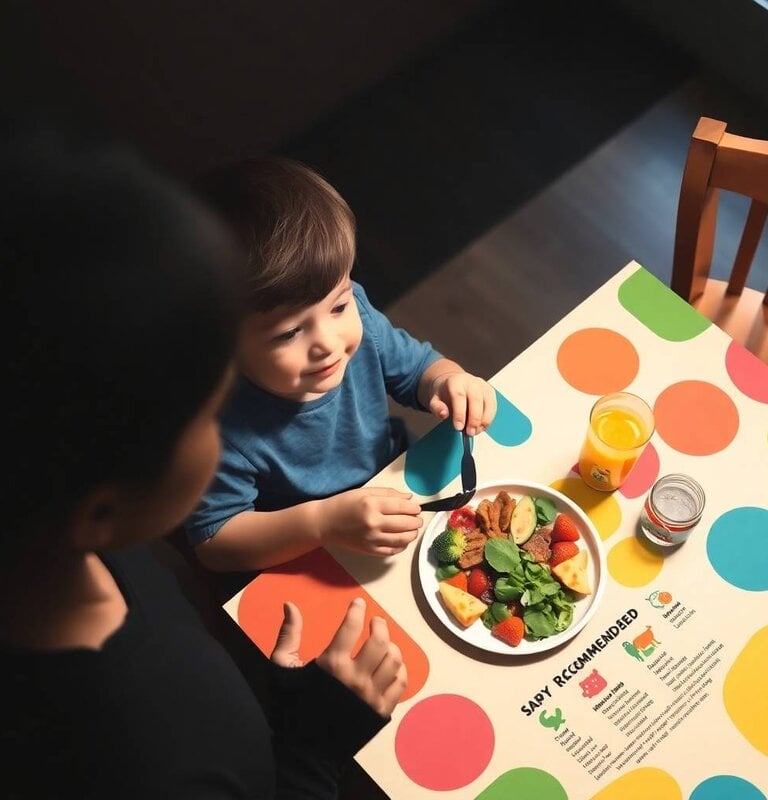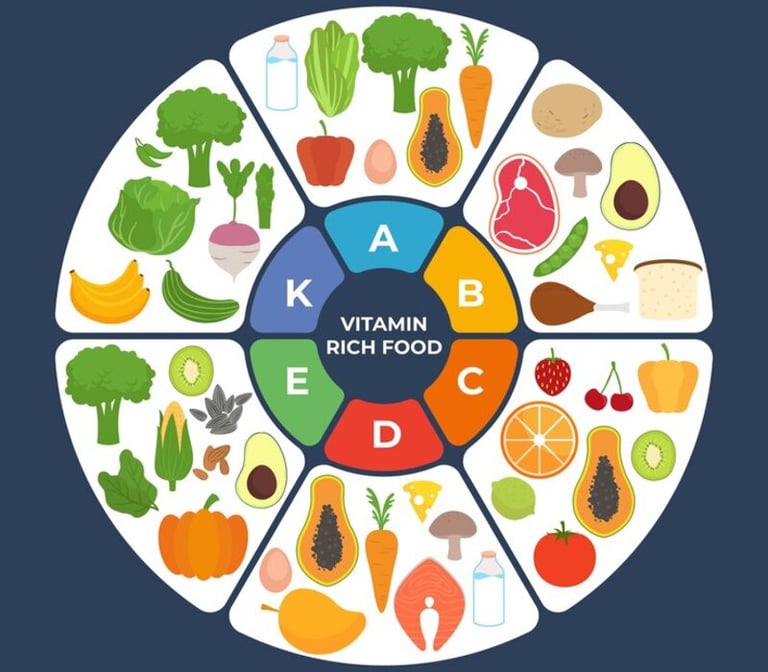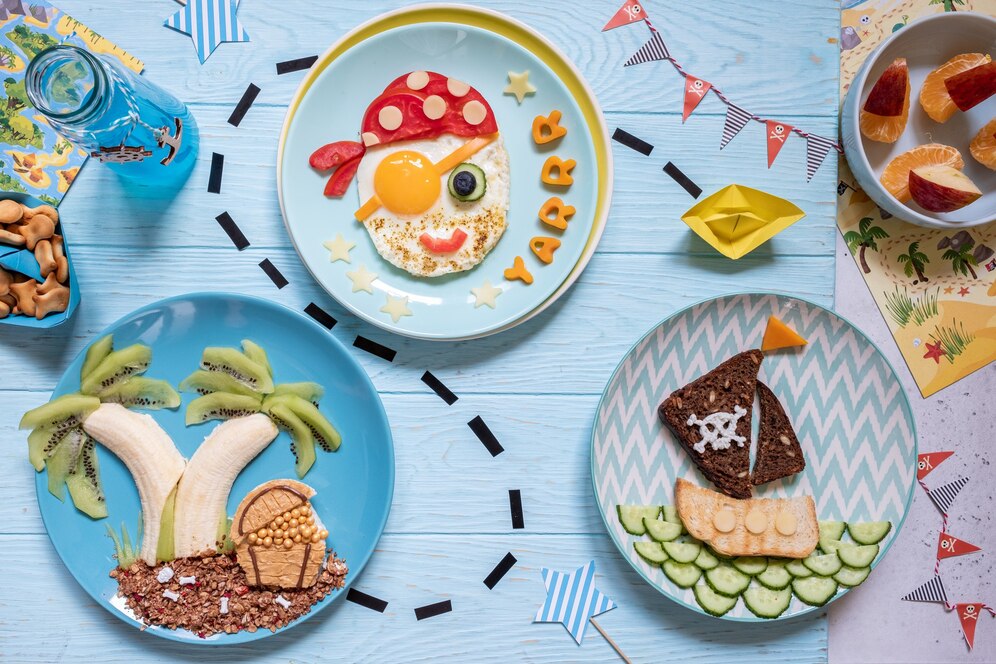Why Is Nutrition Important for Children with Autism?
An balanced diet isn't just a source of energy and physical growth; it plays a fundamental role in the emotional, neurological, and behavioral development of any human. For children with Autism Spectrum Disorder (ASD), this impact is considerably amplified. This is because many bodily and cognitive functions, already potentially altered by the condition, largely depend on the child's nutritional status. An appropriate diet can contribute to better sleep regulation, which is key for children suffering from insomnia or frequent awakenings. Likewise, it promotes a reduction in anxiety and stress levels, directly impacting behavior and attention span. Furthermore, certain foods can act as allies to stabilize mood, improve digestion, strengthen the immune system, and facilitate learning processes.
On the other hand, we must consider that many children with ASD present digestive alterations such as chronic constipation, recurrent diarrhea, intestinal inflammation, food intolerances (like lactose or gluten), and imbalances in gut flora (dysbiosis), which negatively impact their overall state. These conditions, if not detected and treated promptly, can cause persistent physical discomfort, increase disruptive behaviors, and worsen social interaction. Therefore, caring for a child with ASD's diet is not a minor aspect, but a priority, strategic, and profoundly humanized action, which can make a substantial difference in their daily well-being and long-term quality of life.


🍽️ Common Eating Challenges


In many homes and therapeutic settings, mealtime can turn into a tense, frustrating, or repetitive moment with an autistic child. A frequent challenge is food selectivity. This means the child only accepts certain foods, often defined by specific traits: they might reject anything not a particular color, or prefer only crunchy textures, or, conversely, entirely soft ones. Some children can't stand mixed flavors, and others refuse new foods if not presented exactly as they're used to.
It's also very common for them to develop rigid eating routines; they eat the same thing daily or resist if food changes brand, packaging, or plate placement. For example, a child might only accept yogurts from a certain container or specific brand of pasta. Many also have oral hypersensitivity, making certain textures, temperatures, or even chewing sounds unpleasant or unbearable. Others experience visual or tactile rejection: they can't stand foods touching, or sauces mixing colors, or they just feel overwhelmed by the plate's look.
All these challenges shouldn't be seen as whims or defiance, but as valid expressions of a distinct neurosensory sensitivity needing understanding, support, and respectful strategies. Forcing, obliging, or ridiculing isn't just counterproductive; it can reinforce rejection and create fear or distress around food.


Multiple strategies can help introduce new foods and transform mealtime into a more pleasant, exploratory, and educational experience. A fundamental first step is to present foods in a visually appealing way, seeking to activate the child's curiosity. This can be achieved by using brightly colored plates, cutting fruits or vegetables into fun shapes, arranging foods on the plate to form faces or themes (for example, making a "sun" with banana slices and tangerine rays), or even allowing the child to choose how to arrange their food.
Another very powerful strategy is to actively involve the child in food preparation. Cooking together not only improves their relationship with food but also promotes self-regulation, emotional bonding, and learning by imitation. The simple act of touching, smelling, mixing, cutting with help, or serving their own plate can motivate them to accept what they previously rejected. Symbolic play can also be part of it: you can play chef, prepare "magic meals," or invent a family restaurant.
Gradual exposure is also key. This means not forcing the child to eat a new food, but allowing them to familiarize themselves with it little by little. For example, placing it on the plate alongside others they already accept, inviting them to touch it, smell it, observe it, without demanding they try it immediately. Repetition without pressure can yield results in the medium term. Every small achievement should be celebrated with praise, positive gestures, or rewards not tied to more food (for example, a favorite song, a sticker, or an activity they enjoy).
Finally, avoiding punishment or scolding is essential. If a child feels that food is a battlefield, they will experience it with tension and rejection. The key is to generate trust, to listen to their signals, and to offer a positive sensory, emotional, and relational experience.
🌈 Practical strategies to improve eating habits
🧠 Key Nutrients in Neurological Development
When discussing nutrition for children with ASD, we must mention the crucial role of certain nutrients that directly support brain function, emotional regulation, and overall well-being. Incorporating these into the diet can make a difference in areas like attention, memory, mood, sleep, and sensory processing.
One of the most important is Omega 3, an essential fatty acid in fatty fish like salmon, mackerel, or tuna, and in flax seeds, chia, and walnuts. This nutrient boosts neuron communication, helps stabilize mood, and can positively impact reducing impulsive or aggressive behaviors.
Magnesium is also vital, involved in over 300 biochemical processes. It aids muscle relaxation, restful sleep, and stress reduction. Find it in bananas, almonds, pumpkin seeds, spinach, Swiss chard, and other leafy greens.
Zinc improves immune function, contributes to hormonal balance, and plays a key role in regulating appetite and taste. It's in lean red meats, chicken, eggs, seafood, legumes, and whole grains.
B complex vitamins, like B6, B9 (folic acid), and B12, are essential for neurological development, neurotransmitter production, and cognitive function. Deficiency can lead to fatigue, concentration issues, or irritability. They're found in liver, whole grains, legumes, eggs, and dark green vegetables.
Finally, probiotics, beneficial bacteria, help balance gut flora, directly linked to emotional and behavioral regulation. The "gut-brain axis" has become highly relevant recently. Incorporate them through fermented foods like natural yogurts, kefir, kombucha, or homemade sauerkraut.




Sugar is a major silent foe to child well-being, especially for kids on the autism spectrum. For years, its impact was downplayed beyond cavities or obesity, but now we know excessive intake links deeply to emotional shifts, behavioral crises, sensory dysregulation, and cognitive issues. In autistic children, whose neurological systems are already more sensitive, these effects intensify: you'll see huge energy spikes followed by sudden fatigue, increased irritability, sleep problems, lower frustration tolerance, and fragmented attention.
It's not just visible sugar, like in candy or sodas, but also "hidden" sugar in hundreds of ultra-processed foods common in lunchboxes and family meals: puffed cereals, flavored yogurts, "natural" juices, cereal bars, dressings, and more. Besides high sugar doses, these often contain chemical additives, artificial colors, flavorings, and synthetic sweeteners that can negatively affect behavior in sensitive children. Often, the effect isn't immediate but cumulative, adding extra burden to the nervous and intestinal systems.
However, reducing sugar doesn't mean abruptly cutting out all sweet foods, which can cause anxiety, rejection, and frustration for both kids and families. The key is to design a progressive, empathetic, and creative change process. This path should respect the child's current tastes but lovingly guide them toward more nutritious options. For instance, start by replacing sodas or packaged juices with fresh water and slices of orange, lemon, cucumber, or strawberries. This simple swap not only hydrates but also stimulates senses through color, aroma, and taste, creating a positive experience.
Instead of preservative-filled industrial products, incorporate homemade recipes with natural ingredients: oat and banana muffins, carrot and honey muffins, avocado mousse with dark cocoa, baked fruits with cinnamon, unsweetened compotes, or homemade natural juice jellies. These foods are healthier and offer chances for culinary learning and emotional bonding when prepared together.
Reading labels is another key step. Many "kid-friendly" or "healthy"-looking products are full of hidden sugars under unfamiliar names like high-fructose corn syrup, maltodextrin, dextrose, maltose, inverted sugar, or glucose. Spotting and avoiding these ingredients can bring real, tangible changes in mood, attention, and behavior in days or weeks.
The principle of gradual exposure is also valuable here. If a child is used to a certain brand of cookies, start by offering a similar homemade version, then one with fewer ingredients, moving towards more natural options like dried fruits, nuts, or apple chips. The important thing is not to force, but to support with small, consistent steps over time.
Always apply positive reinforcement: praise small steps (like trying a new food, looking at or touching something different, or accepting an alternative), celebrate healthy independent choices, and express gratitude when the child cooperates. These gestures strengthen the bond and foster a positive relationship with food.
Above all, remember a basic rule: never use food as punishment or a threat. It's not about "eating well to behave well," but about helping the child understand how certain foods impact their body, energy, and emotions. Eating should remain a loving, shared, and meaningful experience. Our goal isn't blind obedience, but for the child to understand, participate, feel like a protagonist in their well-being journey, and joyfully discover that eating well can also be pleasurable.
🍬 Sugar, Behavior, and Autism: A Relationship to Better Understand


🥗 Complete Nutrition Guide for Children with ASD – More Content, More Value
Feeding children with Autism Spectrum Disorder demands a highly thoughtful strategy, focusing not just on nutrients but also on sensory, emotional, and family dimensions. This guide offers an expanded approach for each mealtime, including multiple options, insights, and holistic benefits, providing rich and deep content.
🌅 Breakfast – Start the Day Full of Energy and Sensory Input
Practical Options:
🥛 Plant-based milk (almond, oat, or coconut) with soft cereals
Benefits: Provides calcium and magnesium for healthy bones and relaxation. Ideal for lactose intolerant individuals. Add a touch of cinnamon for improved digestion.
🍞 Gluten-free toast with avocado and soft-boiled egg
Benefits: Healthy fats from avocado (omega-9) and choline from egg, essential for memory and attention.
🍌 Banana, mango, and almond milk smoothie
Benefits: Rich in potassium, vitamins A and C; creamy texture, easy to consume, and stimulating.
🥄 Natural yogurt with strawberries and ground seeds
Benefits: Combines probiotics for gut flora and omega-3 in a fresh, friendly preparation.
🥯 Oat, grated apple, and cinnamon muffin (sugar-free)
Benefits: Slow-release oats for sustained energy; fiber from apple and digestive cinnamon.
Recommendations:
Choose attractive tableware with colors or designs.
Present 2-3 options for the child to select.
Use molds for fun, creative shapes.
Allow active participation: serving or mixing.
Implement gradual changes: small adjustments in presentation or ingredients.
🍽️ Lunch – Holistic Nutrition, Digestion, and Regulation
Practical Options:
🍗 Baked chicken with sweet potato and carrot puree
Benefits: Lean protein for muscle development; beta-carotenes for eye and immune health.
🐟 Hake fillet with rice and zucchini
Benefits: Light omega-3 for the brain; zucchini provides hydration and vitamins.
🥩 Beef strips, potatoes, and steamed broccoli
Benefits: Heme iron for brain oxygenation; antioxidants from broccoli.
🍔 Homemade chicken burger with rice and glazed carrots
Benefits: Appealing combination, no ultra-processed ingredients.
🍚 Rice, lentils, and hard-boiled egg
Benefits: Complete proteins; essential iron, zinc, and B vitamins.
🍝 Rice noodles with natural tomato sauce and cheese
Benefits: Lycopene from tomato; protein and calcium from cheese.
Recommendations:
Keep foods separate if there's sensitivity to mixtures.
Avoid strong flavors or intense spices.
Use molds to playfully present portions.
Involve the child in choosing the menu or decorating.
Maintain a calm environment, free from screen distractions.
🍪 Healthy Snacks – Breathe, Reconnect, Emotional Calm
Practical Options:
🥞 Oat pancakes with raspberries and honey
Benefits: Slow carbs and antioxidants; honey as a natural calming agent.
🥤 Peach smoothie with plant-based milk
Benefits: Freshness, hydration, vitamins, and good digestion.
🧁 Homemade pumpkin and cinnamon muffins
Benefits: Digestive aid and antioxidant effects.
🍎 Grated apple with lemon and raisins
Benefits: Fiber for healthy transit.
🧀 Cheese sticks with rice crackers
Benefits: Quality proteins and crunchy texture without irritation.
🍠 Baked sweet potato chips
Benefits: Beta-carotene and a healthy alternative to fried foods.
🍇 Peeled grapes with cream cheese and seeds
Benefits: Hydration, natural sweetness, light protein.
Recommendations:
Involve the child in preparing snacks.
Allow sensory exploration with hands.
Avoid additives and artificial colors.
Transform the moment into a positive sensory activity.
🍓 Afternoon Snack – Energy and Healthy Socialization
Practical Options:
🍌 Banana with peanut butter
Benefits: Magnesium and quick energy with protein.
🥜 Mixed nuts and seeds
Benefits: Antioxidants and healthy fats (check tolerance).
🥕 Vegetable sticks with shredded cheese
Benefits: Vitamin A for vision; fiber and crunchy texture.
🍪 Homemade oat, coconut, and raisin cookies
Benefits: Sustainable energy and healthy transit.
🧃 Frozen fruit cubes (popsicle style)
Benefits: Hydrating and refreshing, no added sugar.
🍞 Rice toast with hummus and tomato
Benefits: Plant proteins, gentle fiber, and natural flavor.
Recommendations:
Present in decorated jars.
Make it part of daily activities.
Avoid ultra-processed products.
🍲 Dinner – Gentle Close, Calm, and Sleep Preparation
Practical Options:
🍲 Creamy pumpkin soup with soft croutons
Benefits: Digestive, comforting, beta-carotenes and potassium for rest.
🥚 Omelette with cheese and grated vegetables
Benefits: Proteins, vitamins, and easy to chew.
🐟 Steamed fish with potatoes and peas
Benefits: Omega-3 and gentle starches that induce satiety.
🥘 Lentil stew with carrots and lean meat
Benefits: Combination of iron and protein for nighttime recovery.
🍚 Rice with chicken and spinach
Benefits: B-vitamins, iron, and a balanced combination.
Recommendations:
Dinner without screens or loud noises.
Mild, familiar flavors.
Allow exploration without pressure to eat.
📝 Extras: General Tips for Respectful and Sensory-Friendly Eating in Children with ASD
Feeding children with Autism Spectrum Disorder (ASD) goes far beyond "eating healthy." It involves sensory, emotional, communication, and behavioral aspects that must be approached with empathy, patience, and creativity. These tips aim to facilitate that process, reduce mealtime stress, and foster a positive relationship with food.
📌 1. Allow tactile exploration of foods
💡 Why it's important? Many children with ASD process world information through touch. Letting them touch, smell, or manipulate food before eating it can be a safe, pressure-free way to get familiar with new tastes and textures. Tactile exploration also reduces anxiety and sparks natural curiosity.
📍 Extra Tip: Offer divided plates with different textures so they can choose what to interact with first. Don't force them to eat; just let them experiment.
📌 2. Avoid mixing everything on one plate if there's sensory selectivity
💡 What does this mean? Many kids with autism experience "sensory aversion": they might reject foods due to texture, temperature, smell, or even color. When everything is mixed (e.g., rice with sauce, meat, and vegetables), it can lead to automatic rejection.
📍 Extra Tip: Present foods separately, using compartmentalized trays or flat plates with sections. This not only improves acceptance but helps identify specific preferences.
📌 3. Include visual routines (drawings or photos of daily menu)
💡 Why is it useful? Visual aids help anticipate what's coming, reducing anxiety from the unexpected. Showing images of breakfast, lunch, snack, and dinner (with real drawings or icons) helps structure routines and improves communication, especially for non-verbal children.
📍 Extra Tip: Create a "weekly menu" with images on the fridge or wall. Involve the child in setting it up, and let them choose between 2 or 3 options per meal.
📌 4. Maintain regular meal times and calm eating environments
💡 Why is it fundamental? Children with ASD greatly benefit from routines. Eating at the same time and place daily creates predictability and security. Noisy environments, with bright lights or screens, can overstimulate them and make eating difficult.
📍 Extra Tip: Create a calm corner with a comfy chair, preferred utensils, and no distractions. Use warm, soft lighting. If possible, establish a gentle "song" or sound to mark the start of mealtime.
✨ Overall Benefits of Applying These Tips:
📈 Improves emotional relationship with food.
🍽️ Increases gradual acceptance of new foods.
🧠 Decreases anxiety and avoidance behaviors.
🧩 Promotes child's autonomy and participation in family routine.
👨👩👧 Strengthens the bond between the child and their environment through a positive experience.
🎮
"My mind works differently, which is why I could imagine worlds no one else could see." — Dan Aykroyd 🧠 Actor, comedian, and screenwriter (Ghostbusters). Person with Asperger's Syndrome.
🧩 Free Resource for Families and Professionals
We're gifting you a PDF activity kit, ideal for children with Autism Spectrum Disorder (ASD). It includes cutout cards, games to stimulate attention, coloring activities, playful dynamics, and much more.
📚 This material has been compiled from various autism communities with the goal of sharing, supporting, and enriching learning through love and inclusion.
💖 Download it for free and start enjoying it today!
📥
Are you a Professional or Do You Provide Services Related to ASD?
At MiRutaTEA, we're developing a new section where therapeutic companions, psychologists, speech therapists, psychopedagogues, specialized teachers, and other professionals can showcase their services through our app and website.
🧩 What Will You Be Able to Offer?
Therapeutic services, school support, or stimulation.
Workshops, group activities, or intervention proposals.
Links to your social media or professional website.
Contact information so families can easily find you.
💙 How to Join?
We'll soon launch a low-cost monthly subscription system so you can be part of our community. In the meantime, you can complete the contact form and tell us about your work.
🚀 Join a Network Designed to Connect Families with Professionals Committed to the Inclusion and Well-being of Individuals with ASD.
🔗 One Click Makes a Difference
Follow us on social media and help us reach more families with information about autism and alternative communication.
📲 Your support means a lot! 👇
💙 At MiRutaTea, we believe in the power of every voice.
Your experience can support, inspire, and help someone feel less alone.
🧩 Click the button and join the blog: read, share, and be part of the conversation.
This space is yours too.
